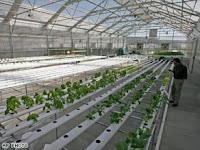Attracting Beneficial Insects
>> Saturday, December 6, 2008
Found a very useful list of plants that attract beneficial insects. It was put together by Steve Zien of Living Resources Company.
While we are preparing our shopping list for our spring garden I thought now would be a great time to choose some plants to attract beneficials. Since my garden is still relatively young, next spring will start its third year, I really haven’t been bothered by many pests. But, I am pretty sure that could change. I don’t use chemical pesticides so choosing the right plants and scattering them strategically around the garden will go a long way to preventing major problems.
As anyone who has gardened for a few years can tell you, aphids, and other pests, have a way of getting out of control very quickly. First a few aphids appear on the cole crops or roses, but the number is so small that you think “what harm can just a few very tiny insects do?” A week later the aphids have doubled in number and it seems as each day passes their population explodes and your plants are showing signs of stress. Now, you start to get concerned. Do you reach for the insecticidal soap spray you’ve been hearing about or do you rely on nature to send some ladybugs your way. Just as it seems you can’t wait any longer those beautifully black-spotted orange ladybugs arrive and you emit a sigh of relief.
If waiting for the chance arrival of ladybugs causes you to loose sleep or makes you bite your nails then maybe it’s time to think about a safer, less stressful, backup plan. Aphids can do quite a bit of damage in a very short time so why not prevent that by providing a habitat that ensures ladybugs are already in your garden to prevent the aphid population from getting so large?
If you are growing a variety of plants you may find that some beneficials are already present. Checking out the list in the link above I discovered that I already have some good homes for beneficials, like yarrow, basket of gold, sweet alyssum, marigolds, carrots, etc. The list is long so the biggest problem is, as usual, finding space for them.
To attract more beneficials consider viewing your garden as an insectary, a habitat where beneficial insect friends will feel at home. Provide them with food, water, and shelter and keep the soil covered with organic matter. You already avoid putting any harmful chemicals into their habitat so you are well on your way to providing what they need most, a safe environment for them to feast to their hearts content.
Further Reading:
Books:
"Pests of the Garden and Small Farm" by UC Davis Entomologist Mary Louise Flint
"The Natural Enemies Handbook" by UC Davis Entomologist Mary Louise Flint
Websites and blogs:
Grinning Planet
Plants for Attracting Beneficial Insects
Gardens Ablaze


















































































